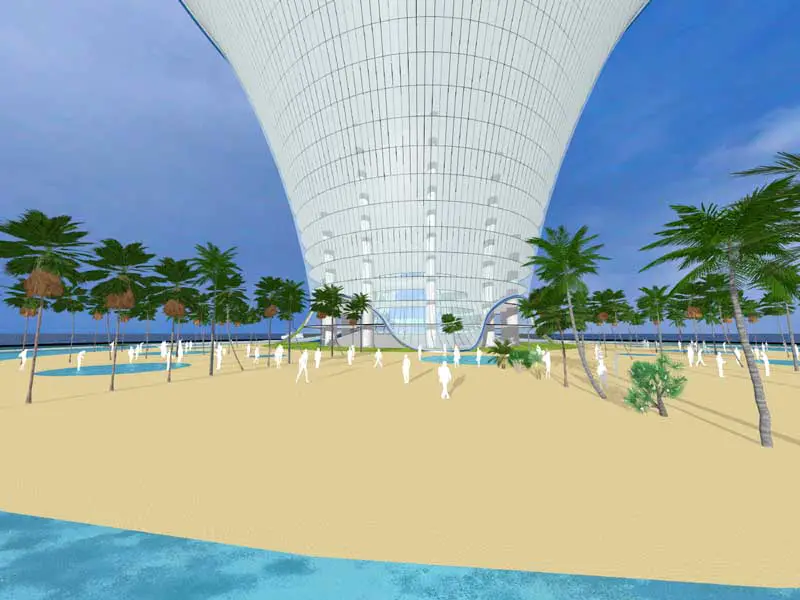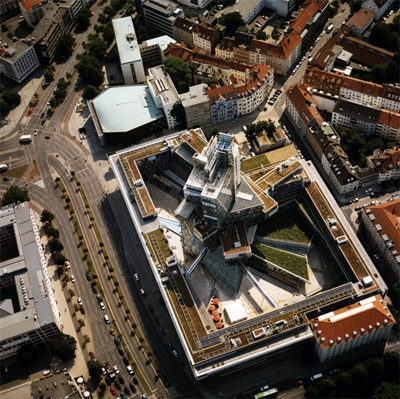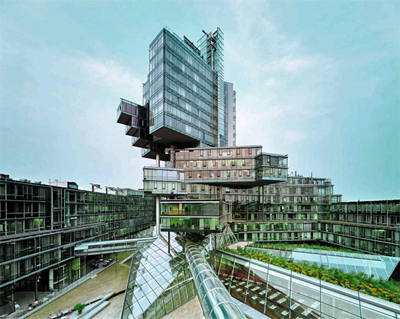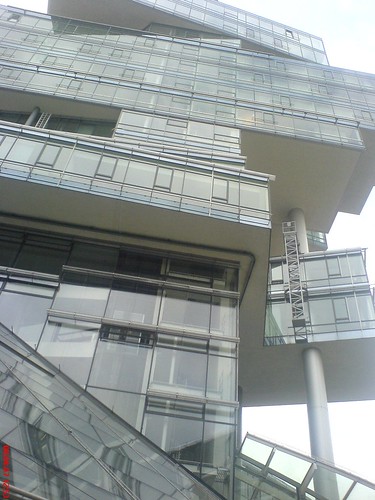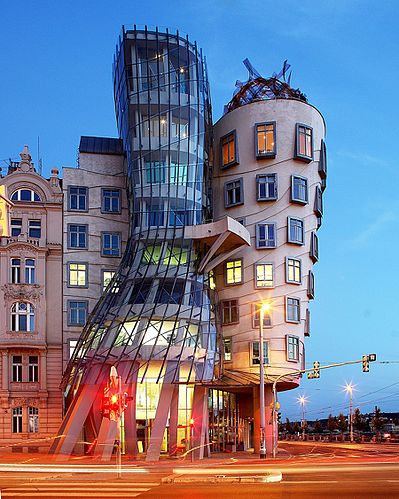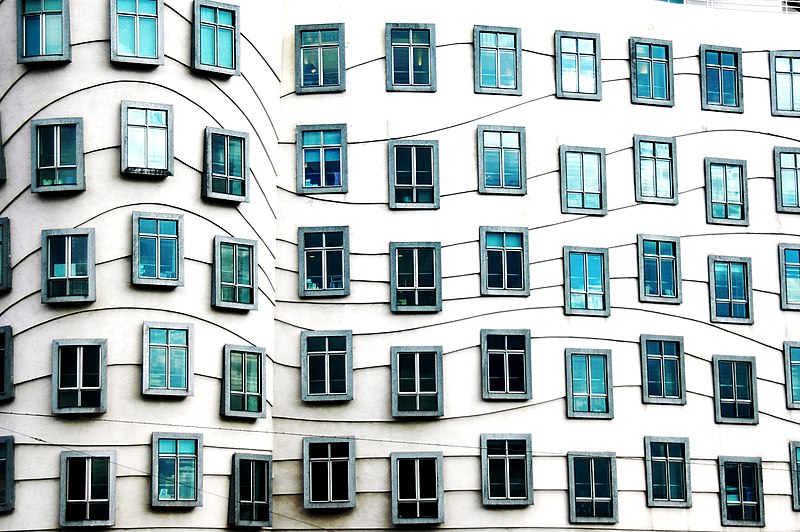The Atomium is a monument in Brussels, originally built for Expo '58, the 1958 Brussels World's Fair. Designed by André Waterkeyn, it stands 102 metres (335 ft) tall. It has nine steel spheres connected so that the whole forms the shape of a unit cell of an iron crystal magnified 165 billion times.
Tubes connect the spheres along the 12 edges of the cube and all eight vertices to the centre. They enclose escalators connecting the spheres containing exhibit halls and other public spaces. The top sphere provides a panoramic view of Brussels. Each sphere is 18 metres in diameter. Four spheres are currently (as of 2012) closed to visitors; others can be reached easily by escalators. The vertical vertex contains a lift which was very fast and advanced at the time of building (the speed is 5 m/s).
Renovation
Renovation on the Atomium began in March 2004; it was closed to the public in October, and remained closed until February 18 2006. The renovations included replacing the faded aluminium sheets on the spheres with stainless steel. To help pay for renovations, the old aluminium was sold to the public as souvenirs. A triangular piece about 2 m long sold for €1,000.
The renovation includes revamped exhibition spaces, a restaurant, and a dormitory for visiting schoolchildren called "Kids Sphere Hotel" which features suspended plastic sphere towers. A €2 commemorative coin depicting the sculpture was issued in March 2006 to celebrate the renovation.
Post renovation
The Atomium is one of the most visited attractions in Brussels today. In 2008, the Atomium celebrated its 50th anniversary, with activities planned all year, including free admission for those turning 50 between April and October.
Location
The Atomium is located at 50°53′41″N 4°20′28″E, on Boulevard du Centenaire, beside the King Baudouin Stadium in Heysel Park. Just next to it are the Mini-Europe park and the Heysel/Heizel metro station.
Safety features
Three of the four uppermost spheres lack vertical support and hence are not open to the public for safety reasons, although the sphere at the pinnacle is open to the public. The original design called for no supports; the structure was simply to rest on the spheres. Wind tunnel tests proved that the structure would have toppled in an 80 km/h wind (140 km/h winds have been recorded in Belgium). Support columns were added to achieve enough resistance against overturning.
Worldwide copyright claims
SABAM, Belgium's society for collecting copyrights, has claimed worldwide intellectual property rights on all reproductions of the image via the United States Artists Rights Society (ARS) . For example SABAM issued a demand that a United States website remove all images of them from its pages. The website responded by replacing all such images with a warning not to take photographs of the Atomium, and that Asbl Atomium will sue if you show them to anyone. Sabam confirmed that permission is required.
Ralf Ziegermann remarked on the complicated copyright instructions on Atomium's website specific to "private pictures". The organisers of Belgian heritage, Anno Expo (planning the 50th anniversary celebrations of Expo '58), in the city of Mechelen announced a "cultural guerrilla strike" by asking people to send in their old photographs of the Atomium and requested 100 photoshoppers to paint over the balls. SABAM responded that they would make an exception for 2008 and that people could publish private photographs for one year only on condition they were for non-commercial purposes.
Anno Expo later announced they had censored part of their own report due to "complications" and referred to a meeting they had with SABAM. Mechelen's Mayor, Bart Somers, called the Atomium copyright rules absurd.
On February 23, 2009 Axel Addington, Web Content Manager for Atomium, e-mailed a clarification to the Glass Steel and Stone web site, which some years earlier redacted its photographs of the Atomium after being threatened. He stated, "The royalties are perceived (sic) by the descendants of Andre Waterkeyn, the engineer who conceived Atomium in 1955, and not by the A.S.B.L Atomium. So, you've probably been sued by the SABAM (Belgian Copyright Company) because of the Waterkeyn Family."
From the Atomium's website, the current copyright restrictions exempt private individuals under the following conditions,
There are some cases however where use of the image of the Atomium is not restricted by any rights. This is the case where photographs are taken by private individuals and shown on private websites for no commercial purpose (the current trend for photo albums), as long as these pictures are displayed at a low resolution (600 pixels maximum, resolution of 72dpi) to avoid abusive usage and downloads. However, the words "© www.atomium.be - SABAM 2010 - photographers name" must be included next to the image.

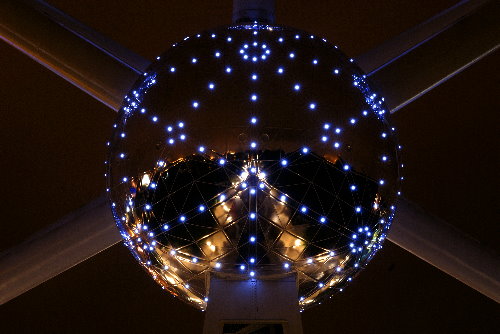
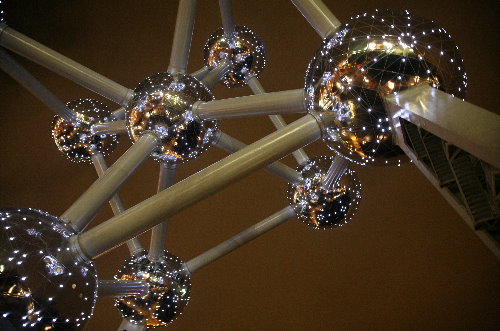
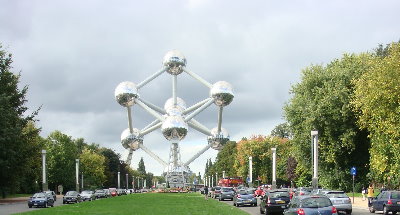
The Atomium is located next to Mini-Europe park (which has miniatures of the famous monuments of EU at a scale of 1:25) beside the King Baudouin Stadium. It is a structure which represents a unit cell of an iron crystal. True to its representation, it has nine spheres made of steel (earlier it was made of aluminum) connected by tubes along the twelve edges of the cube. The structure is 334.6 ft. high with the spheres having diameter of 59 ft. Its stability is ensured by three bipods. The details of the spheres and the locations of the various attractions within the spheres are given in the image here. Please click on the image to enlarge.
The Atomium was built for Expo’1958 – the 1958 Brussels World fair in Belgium. It was designed by Andre Waterkeyn. (the central sphere has been named after him after his demise). The architects were Andre and Jean Polak. It was meant to last just for the Expo (from 17th April to 19th October 1958) but its popularity resulted in it being made permanent. The structure is quite impressive.
It is all the more impressive since the skyline is not spoiled by other tall structures. Inside, the tubes which connect the spheres contain escalators, exhibit halls et al. The top sphere affords an excellent panoramic view of the city including an aerial view of the stadium. Three of the upper spheres are closed to public for safety reasons – since they lack the requisite vertical support.
About the Spheres-
The top and central spheres are accessible only by lift. The others spheres can be accessed by the steep escalators and these cannot be accessed by people on wheelchairs. The base sphere (called Henri Storck sphere) has permanent exhibition dedicated to the fifties. The central sphere has a bar. The kids sphere is meant for sleep overs for children from school. This is not open to the public.
The Atomium was closed for nearly two years between 2004 and 2006 for renovation. This was when the aluminium sheets were replaced with steel ones. The interiors were also redone.
More about the Atomium (Atomium Statistics):
DIMENSION OF ATOMIUM:
Height – 102 metres
Weight – 2400 tons
SPHERES:
Surface – 1082 sq. metres / 240 sq. metres per level
Diametre – 18m
TUBES BETWEEN SPHERES:
20 Tubes
Diameter – 3m
Length – 18m or 23m
BIPODS:
Height – 35m
Steps -200
GROUNDFOOR:
Diameter – 26m
STEPS:
Steps up – 84
Steps Down – 187
Lift Speed – 5m/sec
Construction – 1958
Renovation – 2003-2006
How to get to the Atomium in Brussels –
By metro (subway) – Get down at the Haysel/Heizal metro station on line 1A. This can taken from Station Brussels Central.
By Coach – Take the Brussels Ring Road, then to exit 8 and then follow the direction to Atomium. It’s well marked.
By car – For GPS – Eeuwfeestlaan/Blvd. de Centenaire or Atomium Square
B-1020 Brussels (Laken-Laeken)
Information about getting around in Brussels can be obtained from the following Link.
Opening Hours – Open daily from 10 A.M to 6 P.M.
Atomium and Pavilion of Happiness – April – Oct. timings – 10 A.M to 7 P.M. (Thursdays – open till 10 P.M)
The 50th anniversary celebrations of Expo 58 will take place between April – October 2008.
Ticket Price – Ranges from Free (for Children less than 12 years, Bus drivers & Disabled persons) to € 9 for Adults. Seniors (over 65 years) – € 6. The rates differ for groups. Minimum persons required to qualify as a group is 20. Pavilion of Happiness rate is € 5 for everyone. Combo tickets are also available for Pavilion of Temporary Happiness and Atomium.
For the 50th year commemoration of Expo’58, a number of activities based on the Theme “Brussels Happiness” is taking place.
Atomium address – Atomium Square
B-1020 Brussel (Laken)
Tel. +32 (0) 2/475-47-75
Related Article: Pavilion of Temporary Happiness ;
Tourist info and Transportation in Brussels, Belgium ;
Tourist spots in Bruges
Reference: Official site


